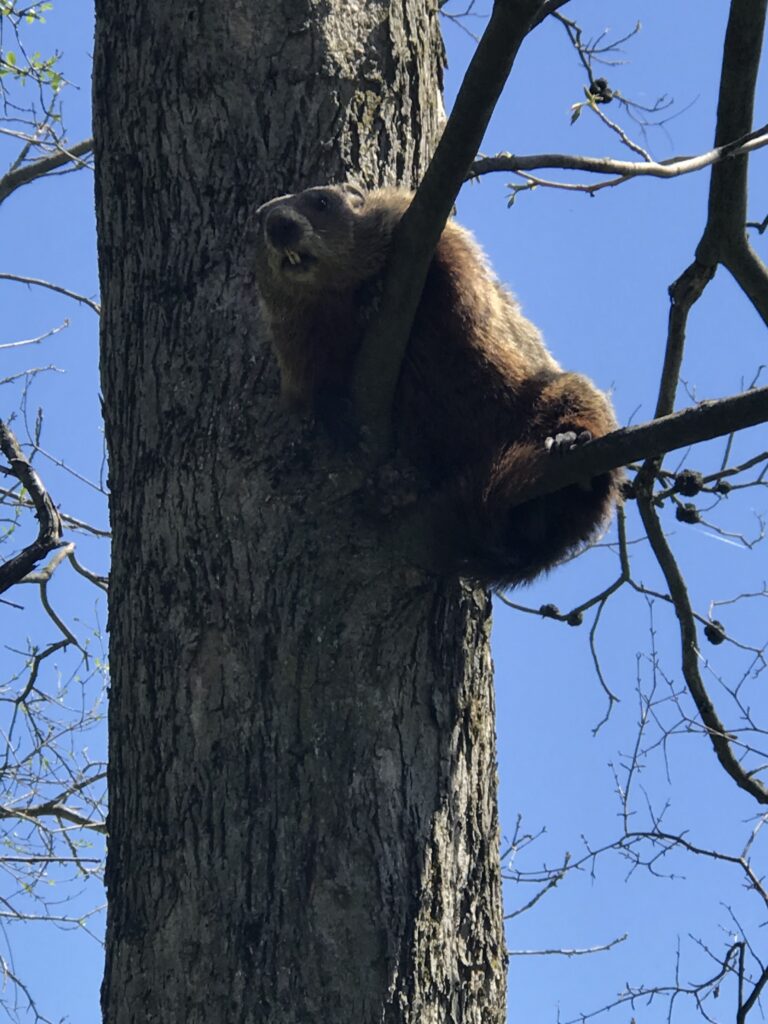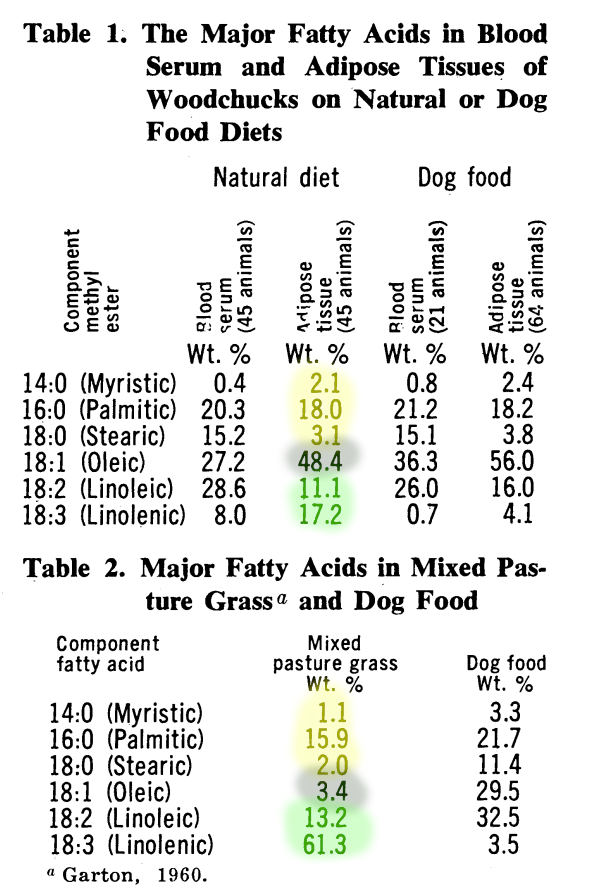In the early spring of 2024 I opened my front door and startled a very fat woodchuck, known as whistle pigs to some country types due to the fact that they are fat like pigs and make a whistling sound when they run, who for whatever reason was under my front steps. As I am want to these kinds of thoughts, I asked myself, “Woodchucks are very fat, do they hibernate?”
Indeed they do. Woodchucks are marmots, a type of hibernating ground squirrel. They eat mainly, mostly grass.
In another life I am a hard cider maker. In THIS life I planted a hard cider orchard but my ADHD and general overcommitment prevented me from putting rabbit guards around the trunks of the young trees before the first winter. During the winter rabbits burrowed under the snow and they girdled – ate the bark off – every one of my cider apple trees and killed every last one.
The point of this story is that rabbits and whistle pigs both inhabit my farm. They exist in the same biological niche – living in burrows in the grassy areas and eating mainly, mostly grass. They are both rodents and they are both hindgut fermenters. But rabbits are very lean and woodchucks are very fat.
The woodchucks are not fat because they ate hyper-processed foods or because modern food is too palatable. Nor do the rabbits stay lean from all of the exercise. Most of their time is spent sleeping in their burrows or standing perfectly still so that hawks don’t see them.
One Time I Saw A Woodchuck In A Tree
Fact! Woodchucks ARE squirrels after all.
It was early spring and you can see that it is still fat.

Grass Is Swamp Food
Denise Minger (to my knowledge) coined the term The Swamp to mean foods that combine fat and carbohydrates (and probably also protein). When you eat ice cream or potatoes with butter you are eating in the swamp. It is generally acknowledged that many people much of the time seem to gain an advantage from restricting certain macros. For some this looks like a low fat vegan diet (fat restricted and medium protein). For others this looks like a keto diet (carb restricted). I’ve recently discussed the Emergence Diet (protein restricted). Some are now doing the sugar diet (both protein and fat restricted).
Grass is a relatively bulky food (high in water) per calorie. Rabbits and woodchucks have large digestive systems relative to their body size to account for this. If you are a hindgut fermenter, the fiber in your food is broken down into short chain fatty acids and absorbed as butyrate. Butyrate, named after butter because it gives butter its characteristic flavor, is fat. So woodchucks and rabbits eat a diet that provides them with roughly equivalent amounts of fat (mostly from fiber), sugar and protein. The definition of a swamp food.

So in theory a woodchuck could get fat from from just eating grass. And in reality the woodchuck does get fat from eating just grass. 100% of the time. Everything is there in the grass that allows the woodchuck to get fat. But the rabbit makes the biological CHOICE not to get fat.
Where is the fat woodchuck during the cold winter? Happily sleeping in its burrow. Where is the lean rabbit in the winter? Burrowing under the snow to eat my apple trees while avoiding hawks. The woodchucks and rabbits chose fatness and leanness for lifestyle reasons.
Is there anything different that we can see in the biology of rabbits and woodchucks? Well, there is fat composition.
So Woodchucks Store Fat From The Grass?
No.
It is proven without a diet that the fats you consume have effects on the composition of the fat stored in your fat tissue AKA adipose tissue. This is a lovely paper from 1965 where someone caught a bunch of woodchucks, measured the fats present in their adipose tissues, fed some of them some dog food to see what would happen. No justification is given for any of this other than “we were curious”. I love this. They also included the fat composition of grass and the dog food used.

I’ve highlighted the fat composition from the woodchuck (upper table) and the grass (lower table). Yellow is saturated fat (butter), green is polyunsaturated (PUFA, grass) and olive drab is monounsaturated (MUFA, olives). What you can see is that the fat profiles of grass and woodchuck are VERY different. The grass is mostly PUFA (linolenic omega-3) and the woodchuck is mainly MUFA (oleic acid).
But you can also see that fat composition is indeed affected by diet. The woodchucks who ate dog food have a higher ratio of omega-6 PUFA (linoleic acid) compared to omega-3 PUFA, just like the dog food they were fed.
So some of the fat in the woodchuck adipose tissue came from the diet but the MUFA has been massively increased.
Rabbit Fat Is Different Than Woodchuck Fat
The lean rabbits have very different fat ratios than woodchucks. Instead of MUFA, they have more saturated fat. If you add up the major saturated fats (14:0, 16:0 and 18:0), the number is ~23 in woodchucks. It’s about 34 in rabbits and stearic acid more than doubles. The lean rabbits are much more saturated.
Lean wild hares (which are apparently different than rabbits, who knew?) have half the MUFA of fat woodchucks. Fat animals are full of MUFA.

PUFA Makes You Fat?
Some people such as myself have alleged that increased consumption of polyunsaturated fats (seed oils) have contributed to the rise in obesity in America since ~1970. I am not backing away from this stance but I think it’s important to understand HOW these different fats affect fat storage.
Clearly the woodchucks are not fat because they ate more PUFA and clearly they are not fat because they retained more PUFA. The simplest explanation on the internet goes something like: PUFA oxidize. Oxidize bad. Mitochondrial dysfunction. PUFA make fat.
The rabbits and woodchucks are not going to allow us to get away with that explanation. Something else is happening.
Fire In A Bottle, Season 4
Why do the lean rabbit and the fat woodchuck have different fat composition?! What does fat composition have to do with fat storage? What is the role of oxygen in all of this?!?!? Why do copepods desaturate the fat of the algae they eat? When and how was this all sorted out? What are anti-oxidants? Why and how do fats oxidize? What is inflammation?
What are the signals that tell us we should be like the woodchucks or like the rabbits?
Buckle up, kids! It’s going to be a wild ride!! We’re going to go 700 million years into the past into the low-oxygen seas of the ediacaran. We’re going to meet a slithering thing that became us. Did you know that the first proto-mammals survived a global extinction event by hibernating? Did you know that mammals belong to the clades of fish, amphibians and reptiles but not to the clade of birds?
What does it all mean? You’ll want to check back.
Cobos, Angel, et al. “Chemical and Fatty Acid Composition of Meat from Spanish Wild Rabbits and Hares.” Zeitschrift F�r Lebensmittel-Untersuchung Und -Forschung, vol. 200, no. 3, 1995, pp. 182–85, https://doi.org/10.1007/BF01190490.
Davis, David E., and Robert D. McCarthy. “Major Fatty Acids in Blood Serum and Adipose Tissue of Woodchucks (Marmota Monax).” BioScience, vol. 15, no. 11, 1965, pp. 749–50, https://doi.org/10.2307/1293540.

Welcome Back!
Been checking daily for a year waiting for the triumphant return.
Thanks for keeping an eye out! This is going to be the best season yet.
We are all eagier to read.
Eagier. That’s the word Im looking for. Im eagier than heck
I’ve been eager to see what your research results would direct us to do with all of our fatness. So glad that you have a lab to go wild in! First saw you talking with Paul Saladino. My sense then was that you would be the one most likely to focus the light and untie the knots in our understanding of diet. Thanks.
Incredible woodchuck picture, and as always you have a really good balance between being entertaining and interesting. It’s always a pleasure to read your articles.
Hi Brad! I’ve missed your stuff! What ever happened with your journey, the 28 day update? Are you still doing heavy Cassava/Florglut/low BCAA/high carb/low fat? Have you emerged with a whole new you? You mentioned gelatinous meats like head cheese/pork but are there other meats that aren’t pork which would works just the same? I add gelatin to grass fed beef and hope for the best. I’d also like to say that as much as I love the technical stuff, I’d also love to read cliff note specifics such as; Swamp diet-does that mean no added fat of any kind to foods or just don’t add pufa? Does that mean don’t mix potatoes with a beef burger or a burger with a bun/onion/toms? Does that mean don’t eat a potato with butter? Don’t eat “grass” with “syrup”? lol…. I look forward to more! So nice to see you back into the swing of things. Since your absence I’ve been listening to Georgi Dinkov/Hyperlipid-Peter/Ray Peat… seems there is a lot of conflicting information to me, but perhaps that’s just me!
Well, I seized an opportunity to start a lab, moved to Buffalo and fell off of the wagon a bit dietarily. I’m slowly pulling it back together and will be filling in more details about what I’m shooting for. Right now I am very excited to get this theory down on (virtual) paper.
what you asked about mixing foods reminds me of an old book on food combining. It basically said when having a protein meal keep the carbs to 20% and vice versa; when eating carbs keep the protein portion down to 20%. He said that when the combination of carbs and protein is too balanced it prohibits the proper digestion of either and that results in putrefaction (rotting) in your gut. Then there was a list of neutral foods that would complement either carbs or proteins in a meal.
If I remember Minger right, “The Swamp” was the low ground between HFLC and LFHC, two extremes that can result in good weight loss. In the murky middle ground, you are eating enough carbs to fuel the body and store most of the fat you eat, which is not ideal according to the narrative. On top of that you are more likely to overeat in general etc and most hyperpalatable lab designed foods are a combo of low quality fats and processed carbs that are hard to consume in moderation.
I am so happy you have decided to write again.